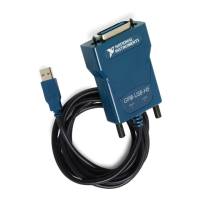Chapter 8 NI-488.2 Programming Techniques
© National Instruments Corporation 8-11 NI-488.2 User Manual
A quick way to convert your application to use per-thread NI-488.2 globals
is to add the following
#define lines at the top of your C file:
#define ibsta ThreadIbsta()
#define iberr ThreadIberr()
#define ibcnt ThreadIbcnt()
#define ibcntl ThreadIbcntl()
Note
If you are using ibnotify in your application (refer to the Asynchronous Event
Notification in NI-488.2 Applications section of this chapter), the
ibnotify callback
is executed in a separate thread that is created by the NI-488.2 driver. Therefore, if your
application makes NI-488.2 calls from the
ibnotify callback function and makes
NI-488.2 calls from other places, you must use the
ThreadIbsta, ThreadIberr,
ThreadIbcnt, and ThreadIbcntl functions described in this section, instead of the
per-process NI-488.2 globals.
Device-Level Calls and Bus Management
The device-level traditional NI-488.2 calls are designed to perform all
of the GPIB management for your application. However, the NI-488.2
driver can handle bus management only when the GPIB interface is CIC
(Controller-In-Charge). Only the CIC is able to send command bytes to the
devices on the bus to perform device addressing or other bus management
activities.
If your GPIB interface is configured as the System Controller (default),
it automatically makes itself the CIC by asserting the IFC line the first
time you make a device-level call.
If the current CIC does not pass control, the NI-488.2 driver returns the
ECIC error code to your application. If this happens, you could send
a device-specific command requesting control for the GPIB interface.
Then, use a board-level
ibwait command to wait for CIC.

